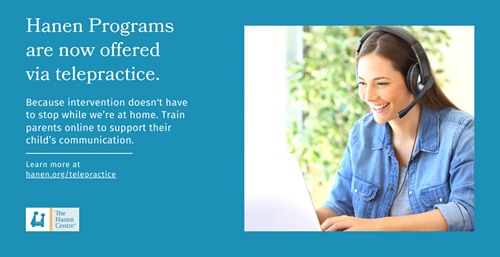Moving Hanen Parent Programs Online!
Lauren Lowry
Hanen SLP and Clinical Staff Writer


For many years, delivering Hanen Programs for parents meant gathering several parents together in-person for group sessions, and then meeting with families and their children individually in our clinics or in their homes for individual video feedback sessions. More recently, with the aim of reaching as many families as possible, we’ve come up with some creative ways to use technology to help more families support their child’s communication development. Now, more than ever, this new way of providing parent-implemented intervention – known as “telepractice” – is proving to be invaluable as many in-person services are limited or prohibited due to COVID-19.
▷ What is telepractice?
Telepractice is the term most commonly used when speech-language pathologists provide assessments or intervention remotely using technologies such as phone, email, or videoconferencing [1]. These services can be live (delivered in real-time) and/or recorded for the client to review later (e.g. videorecordings or audiorecordings) [2]. Other terms such as “telespeech” and “speech teletherapy” are also used by speech-language professionals [1].
▷ Why work with families via telepractice?
There are many advantages to working with families via telepractice [2]:
- Accessibility – issues related to mobility, transportation, childcare, weather, and distance are avoided. This means we can reach families that may not otherwise have been able to access intervention.
- Flexibility – the family’s and therapist’s schedules can be easily accommodated.
- Efficiency – most of the therapist’s travel time, set up, and clean up between daily appointments is eliminated. This means that we can provide more services and to a greater number of families. Telepractice is also much more efficient for families, who don’t need to spend the time or stress traveling to and from sessions in-clinic.
- Cost savings - costs associated with physical space and materials used with in-person sessions are eliminated (toys, equipment, photocopies, etc.)
- Collaboration – when required, specialized service providers or other team members separated by distance can be accessed remotely.
- Family-centred perspective – with videoconferencing, therapists get a chance to see how the child functions at home during everyday life (versus in a clinic), as well as getting a glimpse at the family’s daily routines.
▷ What does the research say about telepractice?
A recent review by researchers in Quebec [3] looked at 23 studies related to telepractice offered by a variety of rehabilitation professionals (which they refer to as “telerehabilitation”). These professionals included psychologists, physiotherapists, occupational therapists, speech-language pathologists, social workers, and dieticians. They found that most studies reported a significant improvement for more than half of the outcomes they examined.
While some professionals are hesitant to adopt telepractice because they worry it may not be as effective as in-person intervention [4], the review above told a different story. The studies that compared telerehabilitation with face-to-face intervention did not report inferior outcomes. In addition, there was a high level of parent satisfaction with the telerehabilitation programs [3].
The review found various features of telerehabilitation that resulted in better outcomes [3]:
- They included coaching, as opposed to only providing information for parents to try on their own (coaching involves giving the parent feedback and guidance while they practice a new skill or strategy)
- Services were provided at least once per week for at least 8 weeks
- Clinicians were provided with training prior to the start of the intervention
- The therapy focused on the parent (versus targeting the child directly)
- The therapy focused on a behavioural outcome, such as communication, anxiety, or parents’ skills (versus a physical outcome such as motor skills)
The authors concluded that “telerehabilitation might be as effective as face-to-face interventions, across disciplines, for a variety of clinical outcomes” [3, p. 1].
▷ Hanen telepractice programs: Putting research into practice
The features of effective telerehabitation listed in the research review above are all important elements of Hanen telepractice programs for parents. Hanen telepractice programs focus on helping parents to improve their child’s communication skills (a behavioural outcome). This is achieved by meeting regularly with families (once per week for several weeks), during which parents receive information about how to help their child, as well as receiving direct coaching and feedback while they practice with their child. Finally, clinicians receive a lot of training before delivering these programs. Clinicians attend a program training workshop during which they spend two or three days learning about adult education, the Hanen philosophy, the program content, and how to provide coaching and feedback during videotaped parent-child interactions. Clinicians who want to offer a Hanen parent program online then apply for a Hanen telepractice licence, and they are provided with a manual with information specific to Hanen telepractice programs.
When the Hanen programs were converted for telepractice delivery, they were carefully created and piloted to mimic the experience provided during the in-person programs. Key evidence-based features of parent-implemented intervention that make the in-person programs effective were maintained, such as:
- collaboratively setting individual goals for the child with the parents
- group parent sessions that include a variety of learning activities using video examples, discussion, role play, and reflection
- individual coaching and video feedback sessions with each family
Families and clinicians who have participated in Hanen telepractice programs report high levels of satisfaction and similar outcomes to in-person Hanen programs, just as the researchers found in the above research review.
▷Which Hanen Programs can be offered via telepractice?
We currently have four Hanen Programs for parents that can be offered via telepractice:
▷ Who can deliver a Hanen telepractice program?
In order to offer a Hanen telepractice program for parents, you first need to attend one of our program certification workshops. These workshops provide you with the tools you need to offer an in-person Hanen parent program. Then, if the program you are certified to deliver has a telepractice option, you are eligible to obtain a telepractice license for that Hanen program. The license provides access to the Telepractice Manual, as well as downloadable program session slides and fillable forms which have been modified for telepractice.
▷ How can I learn more about Hanen telepractice programs?
If you would like to add telepractice to your toolkit for helping parents support their child’s early language development, you can learn more about Hanen telepractice programs here. You’ll also find links at the bottom of the page to the various Hanen programs that have telepractice license options. We hope you’ll consider attending one of our certification workshops and think about adding a telepractice license so that you can reach more families with this new, exciting method of delivering intervention.

References
- American Speech-Language-Hearing Association (n.d.). Retrieved online June 12, 2020 https://www.asha.org/practice-portal/professional-issues/telepractice/.
- Speech-Language & Audiology Canada (SAC). (2015). SAC Position Paper on the use of Telepractice for SAC S-LPs and Audiologists. Retrieved online June 15, 2020: https://www.sac-oac.ca/sites/default/files/resources/sac_telepractice_position_paper_english.pdf
- Camden, C., Pratte, G., Fallon, F., Couture, M., Berbari, J., & Tousignant, M. (2019, April). Diversity of practices in telerehabilitation for children with disabilities and effective intervention characteristics: Results from a systematic review [published online ahead of print]. Disability and Rehabilitation, 1‐13. doi:10.1080/09638288.2019.1595750.
- Hines, M., Lincoln, M., Ramsden, R., Martinovich, J. & Fairweather, C. (2015). Speech pathologists’ perspectives on transitioning to telepractice: What factors promote acceptance? Journal of Telemedicine and Telecare, 21(8), 469-473.